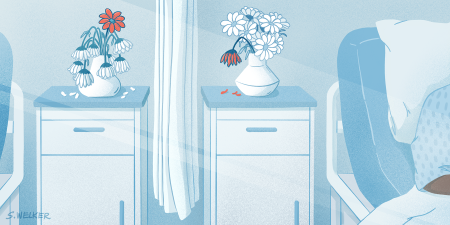Abstract
Physicians have a long-standing obligation to consider social implications of their practice and its potential influences on health policy. One example of a practice’s influence on policy is determining death by neurologic criteria. By lobbying policymakers, maintaining their diagnostic skills, participating in national medical societies, and contributing to robust discourse, physicians can positively influence practice and policy about death determination by neurologic criteria.
Physicians’ Roles in Health Policy
Since the establishment of the Hippocratic School, physicians have endeavored to treat and prevent illness. The American Medical Association (AMA) Code of Medical Ethics continues this tradition in Opinion 8.11, “Health Promotion and Preventive Care,” which states: “While a physician’s role tends to focus on diagnosing and treating illness once it occurs, physicians also have a professional commitment to prevent disease and promote health and well-being for their patients and the community.”1
Physicians hold positions of respect in society and are a trusted group to inform health care policy development. A 2009 Gallup poll revealed that 73% of Americans had confidence in physician recommendations for health care reform, while only 34% and 42% of Americans had confidence in Republican and Democratic congressional leaders, respectively.2 Indeed, trust in the integrity of physicians remains high; however, trust in leadership of the medical profession has declined significantly since the 1960s.3
Misdiagnosis of death reduces public trust in the ability of medicine to accurately determine death.
However, the increasing complexity of health care in the 21st century seemingly poses barriers to physicians’ shaping of health policy. Profound changes have occurred in professional reimbursement, resource allocation, and pharmaceutical marketing and development, as well as in financial support for research. Furthermore, the digital revolution has enabled increased attention to quality and safety, regulation compliance, and clinical documentation integrity. While all of these demands have increased the quality of care delivered, they likely have contributed to burnout in health care, as performance expectations grow out of proportion to increased efficiency in workflow. Meanwhile, the ethical dimensions of practice have become more complex, as scientific advances push the boundaries of what is achievable while some consumers increasingly desire more involvement in their health care decisions. The combination of increasing demands on physicians and increasingly complex clinical, social, and ethical questions leaves physicians with deficits of both time and knowledge that prevent them from attempting to influence health policy through traditional lobbying efforts. Nevertheless, by maintaining excellence in diagnostic skills, participating in national medical societies, and contributing to a robust discourse, physicians can have a positive influence on public policy.
Lobbying
The traditional approach to influencing public policy is to correspond with policy creators, just as any private citizen can. The AMA has offered guidance on how individual physicians can communicate with congressional representatives through letter writing, emails, phone calls, and personal visits.4 Such approaches have been shown to be effective and commonplace, with a 2000 survey of legislative assistants to congressional members estimating that approximately 29 000 personal meetings between physicians and legislative assistants occur annually, at which meetings issues such as reimbursement, managed care, and research concerns are discussed.5 While lobbying is commonly considered to be an influencer of public policy, several other approaches should be considered, which will be explored in the remainder of this paper with a focus on policy for determination of death by neurologic criteria.
Maintaining Standard of Care
Support for physicians and the positions for which they advocate are based on public trust. This trust is earned by an evidence-based approach to clinical care, maintenance of competency, and physicians’ putting their fiduciary responsibility to their patients and community over their own potential personal gain.6 Even with extensive training, however, physicians still commit diagnostic errors. The higher the risk of an incorrect diagnosis, the more time, effort, and attention should be devoted to reducing the risk of misdiagnosis. Physicians should be very cognizant of the fact that a patient who has endured a devastating neurologic injury not amenable to correction can still be negatively impacted by their decisions and determinations. The finality of a diagnosis of death by neurologic criteria does not allow room for error. A determination of death changes the calculus of risk and benefit for the patient, and the family might endure additional psychological distress after an already tragic event if a diagnosis is not made correctly or according to professional standards.
Misdiagnosis of death reduces public trust in the ability of medicine to accurately determine death. We never know how even one misstep might reverberate through the community and have a long-lasting impact. Repeated experiences might have a greater cumulative effect and eventually lead policymakers to believe that changes in the law are needed to address limitations in practice. Therefore, the first step in positively influencing public policy regarding brain death determination is to pursue excellence in clinical practice and to avoid misdiagnoses.
Many tools are available to avoid a misdiagnosis of death. Following established recommendations by the American Academy of Neurology7 will increase fidelity in diagnosis of brain death as well as mitigate public perception that criteria for determining death are arbitrary. Check lists and templates (such as those available from the Neurocritical Care Society Brain Death Toolkit8) can help ensure that all essential clinical criteria are given appropriate consideration in the determination if brain death. Furthermore, all physicians need to have the integrity to self-assess whether their experience in determining death is sufficiently frequent and their training sufficiently up-to-date that they will be able to make an accurate brain death determination. Physicians must maintain their professional integrity, and shortcuts that might reduce the accuracy of the diagnosis should be avoided.
Professional Advocacy
Physicians can influence policy through participation in professional societies. Membership in a professional society is for the purpose of not only improving knowledge and skills, but also ensuring that members are beholden to a code of behavior guiding the execution of those skills. In addition to peer accountability, society participation includes the benefit of continuing education, networking with current and future colleagues, and opportunities to share experiences and opinions on topics for which consensus might not have been reached or is breaking down. While individuals might believe they have a limited voice on the national stage, medical societies often develop specific committees focused on advocating for changes in public policy, such as the American College of Physicians Health and Public Policy Committee.9 Society advocacy reduces the chance that any singular political motivation is at the heart of a position and ensures that concern for the public welfare is the motivating factor for engagement. Professional societies depend on the volunteerism of their members for committee service, presentations, and contribution to position papers. State medical societies also perform a similar role, as laws regarding determination of death by neurologic criteria are often state based.
Partner With Stakeholders
A healthy discourse in the medical literature on what requires further development and incorporation into society position statements is essential to the development of public policy. Although policymakers can choose the position papers and data that support their agenda, physicians ought still to endeavor to honestly discuss and explore various perspectives, including empirically supported claims. Reading the medical literature, responding with letters to the editor, and initiating discussions at national conferences all constitute participation in the discourse, which can influence not only policy changes but also public opinion if consensus opinions find their way into news media.
Determination of death by neurologic criteria has garnered much attention from the academic world. Academics, however, have a tendency to work in their own “silo,” which is a very ineffective approach for complex issues addressed on a national scale. It would be a grave error to assume that one group has the only voice that matters and that other voices can be dismissed. Neither a purely empirical approach nor a philosophical discussion of the underpinnings of death are adequate to complete our understanding of neurologic criteria. Physicians who determine death by neurologic criteria should both be familiar with and contribute to the scientific knowledge base as well as legal and philosophical arguments about neurologic criteria for determination of death. Likewise, lawyers and ethicists should become familiar with clinicians’ experience. I would argue that the best approach is for authors from different fields to collaborate on manuscripts to create a more robust discourse. Consideration of controversial or dissenting opinions is essential to the development of a thorough understanding of and consensus on neurologic criteria that are logically consistent and have practical application.
Conclusions
Physicians can choose among many different approaches to interact with policy leaders to positively influence understanding of brain death and motivate efforts to standardize neurologic criteria for determining it. While all physicians should be aiming for error-free determinations of death, some might pursue legislative lobbying, advocate through professional societies, or contribute to the ethical and clinical literatures. Other physicians might choose to spend a significant portion or even all of their later careers in public policy roles.10 Regardless of the approach taken, all physicians have obligations to consider how their activities affect their colleagues, institutions, patients, and society as a whole.
References
-
American Medical Association. Opinion 8.11 Health promotion and preventive care. Code of Medical Ethics. https://www.ama-assn.org/delivering-care/ethics/health-promotion-and-preventive-care. Accessed December 15, 2019.
-
Saad L. On healthcare, Americans trust physicians over politicians. Gallup. June 17, 2009. https://news.gallup.com/poll/120890/healthcare-americans-trust-physicians-politicians.aspx. Accessed December 15, 2019.
- Blendon RJ, Benson JM, Hero JO. Public trust in physicians—US medicine in international perspective. N Engl J Med. 2014;371(17):1570-1572.
-
American Medical Association. Congressional check-up: a guide to physician advocacy. https://www.ama-assn.org/system/files/2019-01/communicating-with-congress.pdf. Published January 2019. Accessed December 15, 2019.
-
Landers SH, Sehgal AR. How do physicians lobby their members of Congress? Arch Intern Med. 2000;160(21):3248-3251.
- Mikhly M. The role of the medical profession in swaying public policy: exploring physician responsibility and advocacy. Einstein J Biol Med. 2015;30(1-2):2-5.
-
Russell JA, Epstein LG, Greer DM, Kirschen M, Rubin MA, Lewis A; Brain Death Working Group. Brain death, the determination of brain death, and member guidance for brain death accommodation requests: AAN position statement [published online ahead of print January 2, 2019]. Neurology.
-
Neurocritical Care Society. Brain Death Toolkit. https://www.pathlms.com/ncs-ondemand/courses/1223. Updated 2017. Accessed July 19, 2020.
-
American College of Physicians®. Health and Public Policy Committee. https://www.acponline.org/about-acp/who-we-are/leadership/boards-committees-councils/health-and-public-policy-committee. Accessed September 1, 2020.
- Khatana SA, Patton EW, Sanghavi DM. Public policy and physician involvement: removing barriers, enhancing impact. Am J Med. 2017;130(1):8-10.



